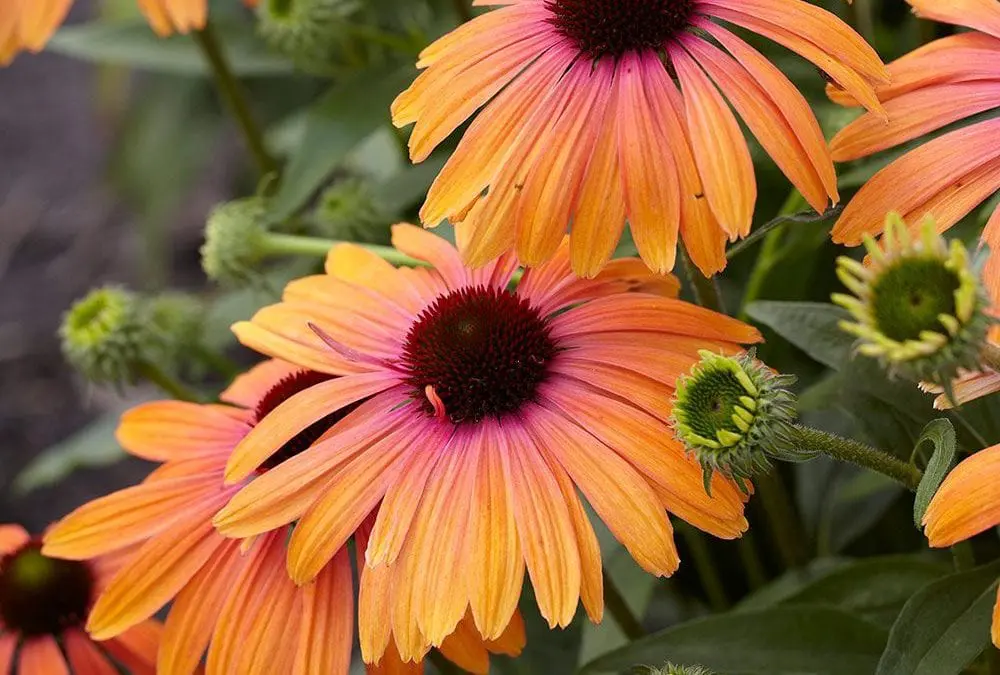While pulling weeds in my backyard on Sunday, it occurred to me that it’s getting dark earlier. On one hand, the shorter days mean that summer is waning. And that’s a little sad. On the other, I’m jolted into landscape productivity. What can I plant into those empty spots? Didn’t I mean to put in a new path? And that shed really needs renovating.
This extra energy has been further boosted by the last couple of week’s cooler than average temperatures. It’s actually comfortable to work in the garden, as long as I spray on enough Eau de DWO. That’s Deep Woods Off, to the layman. And as long as I’m making the effort to plant, I’ll be choosing things that will give me color right now. Hydrangeas, sedums and ornamental grasses are at their best in late summer. But my favorite for those sunny spaces has to be the coneflower.
Coneflowers, or Echinacea, are native to eastern and central North America, where they inhabited prairies and open woodlands. The word Echinacea is derived from the Greek and means hedgehog, probably alluding to the blossom’s spiny central disk or cone. The most common species, E. purpurea, was used medicinally by many Native American tribes to strengthen the circulatory and respiratory systems. Even today, I know lots of people who take Echinacea as soon as they feel a cold coming on.
Coneflowers are at their best in locations that are well-drained and in the sun for at least 6 hours a day. Once established, the plants become quite drought-tolerant as their taproots grow deep. They are rarely troubled by disease or insect pests and they attract all sorts of beneficial bugs, as well as scads of butterflies. The flowering period is long, and re-blooming can be encouraged with regular deadheading.
I find all of this plant lore pretty interesting, but you probably want color in your garden now! Lots of it! The coneflower used to be a rather pretty native with purple-pink flowers, but it has been hybridized into hundreds of choices. Coneflowers can be found in every color of the rainbow, save blue. And not only the color range has exploded. There are so many forms now, from the traditional daisy shape to doubles and pompoms and spoon-billed petals.
So what’s new and exciting in the world of coneflowers? Well. I’m a little obsessed about the brand new Rainbow Marcella. The petals of this bicolor introduction from the Netherlands sport orange sherbet outer tips with raspberry blush centers. The compact plants are hardy to Zone 4 and bloom prolifically from June until frost. And since they are seed-grown, they are a bit tougher than some of the other hybrid varieties.
The plant geniuses in The Netherlands are also responsible for the sweetly-named Marmalade. This double introduction from the Cone-Fections Collection will brighten your border with tangerine-orange pompoms. Flower production will begin to slow in mid-August, but while they’re blooming, the fragrant flowers make a great addition to bouquets and vases.
Fatal Attraction falls into the oldie, but definitely goodie category. The huge, daisy-shaped flowers never droop and the vivid pink petals surround a glowing orange cone. But what makes them really stand out are the deep wine-red stems that contrast so nicely against all of that green summer foliage. Fatal Attraction blooms a bit later than other cultivars, so be patient.
So, find a spot for a coneflower or two. You’ll be thrilled with the pop of color in your summer borders and the hummingbirds and goldfinches will thank you.

